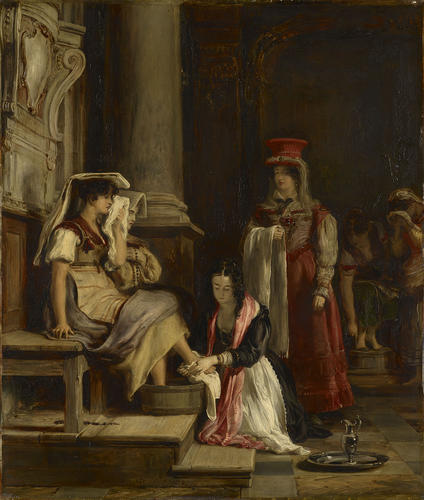-
1 of 253523 objects
A Roman Princess Washing the Feet of Pilgrims Signed and dated 1827
Oil on panel | 50.2 x 42.2 cm (support, canvas/panel/stretcher external) | RCIN 405096

Sir David Wilkie (1785-1841)
A Roman Princess Washing the Feet of Pilgrims Signed and dated 1827
-
David Wilkie was one of the most successful painters of the Regency period and was greatly encouraged by the Regent. Born in Fife, trained in Edinburgh, Wilkie settled in London in 1805 and began regularly exhibiting at the Royal Academy small scale scenes of everyday life. At this time old master genre painting was hugely popular and expensive, as is demonstrated by the many examples of the work of Teniers and van Ostade (Adriaen and Isaac) collected at this time by George IV. Wilkie consciously emulated these low-life scenes, charging similarly high prices, but the meaning of his work shifts with the tide of British culture in the later eighteenth century towards a more celebratory (some would say sentimental) treatment of ordinary people. Teniers painted ‘peasants’; Wilkie painted the ‘the salt of the earth’. Wilkie’s royal career involved succeeding Raeburn as Limner to the King in Scotland in 1823 and Lawrence as Principal Painter in Ordinary to the King in 1830; he remained in these positions until his death, although Queen Victoria disliked his work.
In July 1825 Wilkie set off for an extended visit to the continent, taking in Italy and Spain and even a visit to Delacroix in Paris. George IV acquired six paintings (OM 1177-2, 405861, 405091-4 and 405096) from Wilkie following his return to London in 1828; this is one of a pair (OM 1177-8, 405861 and 405096) for which Wilkie charged 400 guineas. This group of six has considerable coherence and is characteristic of this period of art in general. This is the age during which Spain was ‘discovered’ by writers and artists as was the Italy of modern life as opposed ancient remains, which is the subject of this pair. This was also a period during which the priests, ceremonies and superstitions of the Catholic Church appeared in a good light, by comparison with the godless rationalism of the recently-overthrown armies of the French Revolution. Wilkie’s paintings all depict picturesque life in Italy and Spain, in which faith plays a central part; many depict the actual struggle against Napoleon’s invaders. Wilkie also changed his style during this period, taking the oil-sketches of Rubens as his model, rather than the genre paintings of Teniers, to create something grander, sketchier and more rhetorical.
This is one of a pair of paintings depicting pilgrims, worshipping at a way-side shrine to the accompaniment of the Pifferarii (OM 1177, 405861) and, in this case, having their feet washed ‘this kindly office rendered unto them by a sisterhood composed of the first ladies of rank, the princesses of the place’. The scene takes place in the Church of SS Trinita dei Pellegrini in Rome. A lady, supposed to represent the Princess Doria, kneels to wash the feet of two pilgrims, who wear characteristic hats which ressemble books balanced on their heads; another princess stands behind her with a towel; two more pilgrims are seen behind.
Signed and dated: 'D Wilkie Geneva 1827'Provenance
Purchased by George IV in 1828; added to the inventory of Carlton House dated 1819 (no 639); recorded in the 'Wilkie Bedroom' at Buckingham Palace in 1858
-
Creator(s)
Acquirer(s)
-
Medium and techniques
Oil on panel
Measurements
50.2 x 42.2 cm (support, canvas/panel/stretcher external)
78.0 x 70.7 x 8.0 cm (frame, external)
502 x 435 mm (alternative measurement)
Other number(s)
Alternative title(s)
The Princess Doria, previously identified as